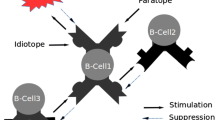Abstract
Biological information processing systems can be regarded as one of the ultimate decentralized systems, and have been expected to provide various fruitful ideas in the engineering field. Among these systems, the immune system plays an important role in coping with dynamically changing environments by constructing self-nonself recognition networks among different species of antibodies, and has many interesting features from an engineering stand-point, such as learning, self-organizing abilities, and so on. However, it has not yet been applied to engineering fields. Therefore we pay close attention to the immune system and attempt to construct an artificial immune network for robot control. In this study we propose a new interpretation of the roles of antibodies in terms of self-assertion and subordination, and apply this idea to a gait coordination problem of a hexapod robot as a practical example. Several computer simulations are carried out, and the robustness against disturbances and the feasibility of our method are confirmed.
Similar content being viewed by others
References
Ichikawa S, Ishiguro A, Uchikawa Y (1995) A gait acquisitions of 6-legged walking robot using immune networks (in Japanese). J Robot Soc Jpn 13(3):125–128
Ishiguro A, Kuboshiki S, Ichikawa S, Uchikawa Y (1996) Gait control of hexapod walking robots using mutual-coupled immune networks. Adv Robot 10(2):179–195
Ishiguro A, Watanabe Y, Uchikawa Y (1994) Fault diagnosis of plant systems using immune networks. In: Proceedings of the 1994 IEEE International Conference on Multisensor Fusion and Integration for Intelligent Systems, pp 34–42
Ishiguro A, Watanabe Y, Uchikawa Y (1995) An immunological approach to dynamic behavior control for autonomous mobile robots. In: Proceedings of the International Conference on Intelligent Robots and Systems (IROS'95), Pittsburg, PA, USA, August 5–9, 1995, pp 495–500
Jerne NK (1973) The immune system. Sci Am 229(1):52–60
Jerne NK (1984) Idiotypic networks and other preconceived ideas. Immunol Rev 79:5–24
Burnet FM (1959) The clonal selection theory of acquired immunity. Cambridge University Press, Cambridge
Brooks RA (1989) A robot that walks: Emergent behavior from a carefully evolved network. Neural Comput 1:253–262
Maes P, Brooks R (1990) Learning to coordinate behaviors. In: Proceedings of AAAI, Boston, MA USA, July 29–August 3, pp 796–802
Beer RD (1990) Intelligence as adaptive behavior: An experiment in computational neuropathology. Academic Press, New York
Yuasa H, Ito M (1990) Coordination of many oscillators and generation of locomotory patterns. Biol Cybern 63:177–184
Lewis MA, Fagg AH, Bekey GA (1994) Genetic algorithms for gait synthesis in a hexapod robot. Advanced mobile robots— theory and applications. International Perspectives, World Publishing, Singapore, pp 317–331
Berns K, Cordes St., Ilg W (1994) Adaptive, neural control architecture for the walking machine LAURON. In: Proceedings of the International Conference on Intelligent Robots and Systems (IROS'94), Munich, Germany, September 12–16, vol 2, pp 1172–1177
Author information
Authors and Affiliations
Corresponding author
About this article
Cite this article
Ichikawa, S., Kuboshiki, S., Ishiguro, A. et al. A method of gait coordination of hexapod robots using immune networks. Artificial Life and Robotics 2, 19–23 (1998). https://doi.org/10.1007/BF02471147
Received:
Accepted:
Issue Date:
DOI: https://doi.org/10.1007/BF02471147




